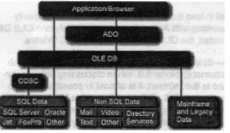

5

 |
 |
5 |
 |
|
The LA Fox Developer Newsletter
|
|
February 2000
|
|
ADO Quickstart
(Con’t from page 1)
VFPCOM.DLL achieves the same results. The topics VFPCOM, ADO Events, and how to integrate ADO and Visual FoxPro will be discussed in another white paper. This paper is dedicated to providing the Visual
FoxPro developer, with a comprehensive overview of ActiveX Data Objects, Remote Data Services (RDS), their respective objects, and how those objects work.
What Are OLE DB and
ADO?
When discussing ADO, we are really talking about two distinct
elements: the ActiveX data objects themselves and Microsoft
Universal Data Access technology, more commonly known as
OLE DB.
OLE DB and Universal Data Access
In simple terms, OLE DB is the succeeding technology to the Open Database Connectivity (ODBC) standard. OLE DB is a set of low-level interfaces that facilitate the Microsoft Universal Data Access strategy. ADO is a set of high-level interfaces for working with data.
While both ODBC and OLE DB have the ability to make data available to a client, the capabilities of the two technologies are very different. ODBC is primarily designed for use on relational data. However, data exists in nonrelational as well as relational formats. In addition to new data formats, data resides in new places such as the Internet. Finally, the Microsoft Component Object Model (COM) framework requires better data access technology. Clearly, ODBC does not address these needs; a new technology is needed. That technology is OLE DB, and it is here to stay.
The following graphic best illustrates how OLE DB and ADO work together. Clients can work directly with OLE DB or can work with OLE DB through the ADO interface (the latter is typically the case). Note that OLE DB can access SQL data either directly or through ODBC. An OLE DB provider provides direct access by OLE DB. Also note that OLE DB can also be used to access a variety of non-SQL data, as well as data that exists in mainframes. The ability to access data through a common interface, without regard to data location or structure, is the real power behind ADO and OLE DB.
|
Whereas ODBC uses drivers, OLE DB uses providers. A provider is a software engine that provides a specific type of data that matches the OLE DB specification. Several OLE DB providers exist today, including those for Microsoft SQL ServerTM and Oracle. Because there is such widespread use of ODBC, an OLE DB provider for ODBC has also been created in order to ease the migration from ODBC to OLE DB. Several nonrelational providers are currently under development. Perhaps the most anticipated of these is the OLE DB Provider for Microsoft Outlook®. A special provider, MS Remote, allows direct data access over the Internet. This brief list of providers shows the third-party community commitment to OLE DB, and many new providers are currently under development. For the latest news on available providers, refer to http:// www.microsoft.com/data/.
ADO Overview
OLE DB is then a set of low-level interfaces that provide access to data in a variety of formats and locations. While powerful, OLE DB interfaces can be cumbersome to work with directly. Fortunately, ADO provides a set of high-level, developer-friendly interfaces that make working with OLE DB and universal data access a relatively simple task. Regardless of the programming environment you use, any Visual Studio® or Microsoft Office product such as Visual FoxPro, Visual Basic, Visual C++®, or Word, the interface you will use to access data remains constant. That interface is ADO, which in turn uses OLE DB.
ADO itself is just a set of objects. By itself, ADO is not capable of anything. In order to provide any functionality, ADO needs the services of an OLE DB provider. The provider in turn uses the low-level OLE DB interface to access and work with data. One ADO connection may use a SQL Server OLE 06 provider and another ADO connection may use an Oracle OLE DB provider. While the interface is constant, the capabilities may be very different because OLE DB providers are very different, which highlights the polymorphic nature of OLE DB.
As developers, we crave consistency. ADO provides us with a consistent interface for our program code.
ADO Version Summary
|
|
Page 5
|

 |
 |
5 |
 |